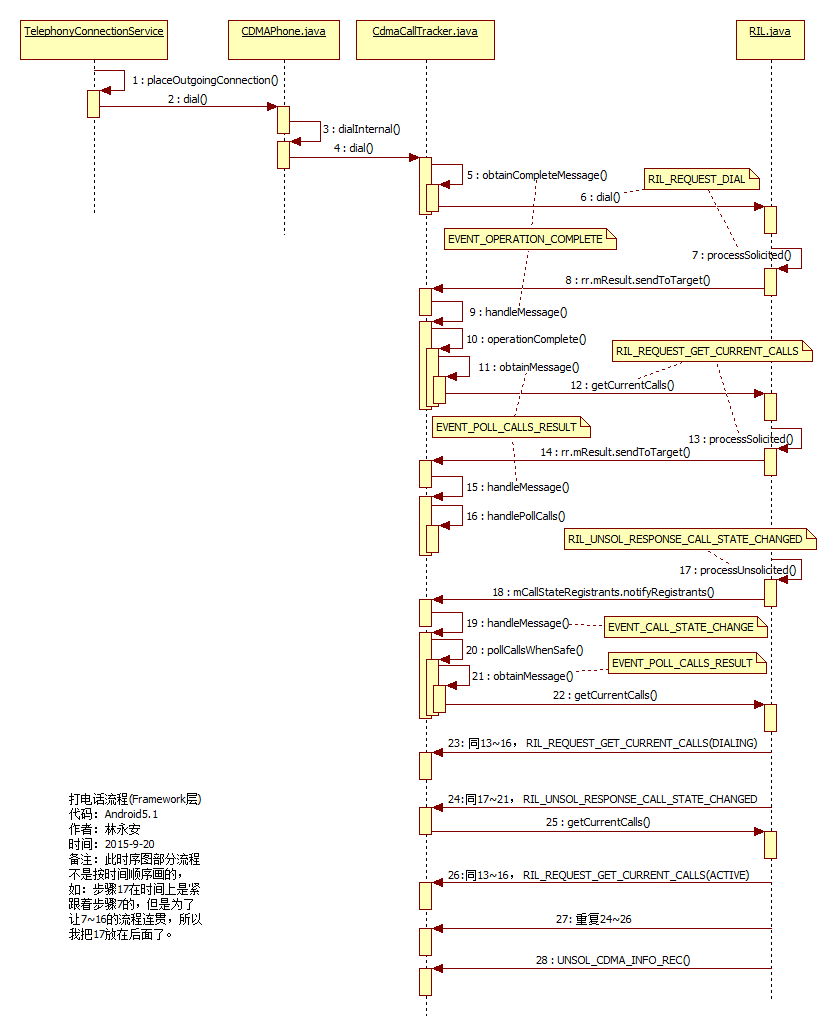写在前面的话
本文主要分析MO(去电)的流程,研究的代码是Android 5.1的,目前只关注Framework层,以CDMA为例。关于应用层的流程,请看《Android 5.1 Phone MO(去电)流程分析(应用层) 》

(如果图片看不清的话,可以右键选择在新标签中打开图片,或者把图片另存到自己电脑再查看。)
步骤1和2:紧接着应用层的流程,在
public Connection dial (String dialString, int videoState, Bundle extras){
...
return dialInternal(dialString, null, videoState);
}
protected Connection dialInternal (String dialString, UUSInfo uusInfo,int videoState) throws CallStateException {
// Need to make sure dialString gets parsed properly
String newDialString = PhoneNumberUtils.stripSeparators(dialString);
return mCT.dial(newDialString);
}
步骤3和4: mCT是CdmaCallTracker类型的,所以我们进入/**
* clirMode is one of the CLIR_ constants
*/
Connection dial (String dialString, int clirMode) throws CallStateException {
// note that this triggers call state changed notif
clearDisconnected();
if (!canDial()) {
throw new CallStateException("cannot dial in current state");
}
String origNumber = dialString;
String operatorIsoContry = mPhone.getSystemProperty(
TelephonyProperties.PROPERTY_OPERATOR_ISO_COUNTRY, "");
String simIsoContry = mPhone.getSystemProperty(
TelephonyProperties.PROPERTY_ICC_OPERATOR_ISO_COUNTRY, "");
boolean internationalRoaming = !TextUtils.isEmpty(operatorIsoContry)
&& !TextUtils.isEmpty(simIsoContry)
&& !simIsoContry.equals(operatorIsoContry);
if (internationalRoaming) {
if ("us".equals(simIsoContry)) {
internationalRoaming = internationalRoaming && !"vi".equals(operatorIsoContry);
} else if ("vi".equals(simIsoContry)) {
internationalRoaming = internationalRoaming && !"us".equals(operatorIsoContry);
}
}
if (internationalRoaming) {
dialString = convertNumberIfNecessary(mPhone, dialString);
}
String inEcm=SystemProperties.get(TelephonyProperties.PROPERTY_INECM_MODE, "false");
boolean isPhoneInEcmMode = inEcm.equals("true");
boolean isEmergencyCall =
PhoneNumberUtils.isLocalEmergencyNumber(mPhone.getContext(), dialString);
// Cancel Ecm timer if a second emergency call is originating in Ecm mode
if (isPhoneInEcmMode && isEmergencyCall) {
handleEcmTimer(CDMAPhone.CANCEL_ECM_TIMER);
}
// We are initiating a call therefore even if we previously
// didn't know the state (i.e. Generic was true) we now know
// and therefore can set Generic to false.
mForegroundCall.setGeneric(false);
// The new call must be assigned to the foreground call.
// That call must be idle, so place anything that's
// there on hold
if (mForegroundCall.getState() == CdmaCall.State.ACTIVE) {
return dialThreeWay(dialString);
}
mPendingMO = new CdmaConnection(mPhone.getContext(), checkForTestEmergencyNumber(dialString),
this, mForegroundCall);
mHangupPendingMO = false;
if ( mPendingMO.getAddress() == null || mPendingMO.getAddress().length() == 0
|| mPendingMO.getAddress().indexOf(PhoneNumberUtils.WILD) >= 0 ) {
// Phone number is invalid
mPendingMO.mCause = DisconnectCause.INVALID_NUMBER;
// handlePollCalls() will notice this call not present
// and will mark it as dropped.
pollCallsWhenSafe();
} else {
// Always unmute when initiating a new call
setMute(false);
// Check data call
disableDataCallInEmergencyCall(dialString);
// In Ecm mode, if another emergency call is dialed, Ecm mode will not exit.
if(!isPhoneInEcmMode || (isPhoneInEcmMode && isEmergencyCall)) {
mCi.dial(mPendingMO.getAddress(), clirMode, obtainCompleteMessage());
} else {
mPhone.exitEmergencyCallbackMode();
mPhone.setOnEcbModeExitResponse(this,EVENT_EXIT_ECM_RESPONSE_CDMA, null);
mPendingCallClirMode=clirMode;
mPendingCallInEcm=true;
}
}
if (mNumberConverted) {
mPendingMO.setConverted(origNumber);
mNumberConverted = false;
}
//更新phone状态
updatePhoneState();
//发起phone状态变化通知
mPhone.notifyPreciseCallStateChanged();
//返回通话连接
return mPendingMO;
}
/**
* Obtain a message to use for signalling "invoke getCurrentCalls() when
* this operation and all other pending operations are complete
*/
private Message obtainCompleteMessage() {
return obtainCompleteMessage(EVENT_OPERATION_COMPLETE);
}
/**
* Obtain a message to use for signalling "invoke getCurrentCalls() when
* this operation and all other pending operations are complete
*/
private Message obtainCompleteMessage(int what) {
mPendingOperations++;
mLastRelevantPoll = null;
mNeedsPoll = true;
if (DBG_POLL) log("obtainCompleteMessage: pendingOperations=" +
mPendingOperations + ", needsPoll=" + mNeedsPoll);
return obtainMessage(what);
}
步骤5:先看EVENT_OPERATION_COMPLETE的Message,这个Message也会传入到mCi.dial方法里,在这里是CdmaCallTracker主动向RILJ(mCi是RILJ的实例对象,后面再解释为什么)发送消息,等RILJ处理完之后通过回调通知CdmaCallTracker,CdmaCallTracker就在handleMessage方法处理。
知识点解析:至于
public CdmaCallTracker(CDMAPhone phone) {
...
mCi = phone.mCi;
...
}
phone是CDMAPhone类型的,在CDMAPhone的构造方法里并没有关于mCi的定义和创建代码,只有super这一行有联系
public CDMAPhone(Context context, CommandsInterface ci, PhoneNotifier notifier,
boolean unitTestMode) {
super("CDMA", notifier, context, ci, unitTestMode);
...
}
我们再进入CDMAPhone的父类PhoneBase的构造方法里,
protected PhoneBase(String name, PhoneNotifier notifier, Context context,
CommandsInterface ci,boolean unitTestMode) {
...
mCi = ci;
...
}
找到mCi的定义和初始化信息:mCi = ci;ci是在CDMAPhone的构造方法里的传递对象,因此,如果找到CDMAPhone创建phone对象的地方,也许可以找到ci的创建。 我们要找CDMAPhone被调用的地方,(在Source Insight这个编译器中,选中CDMAPhone,然后按快捷键Ctrl+/),我们找到
public static void makeDefaultPhone(Context context) {
...
sCommandsInterface = new RIL(context, networkMode, cdmaSubscription);
UiccController.make(context, sCommandsInterface);
int phoneType = TelephonyManager.getPhoneType(networkMode);
if (phoneType == PhoneConstants.PHONE_TYPE_GSM) {
Rlog.i(LOG_TAG, "Creating GSMPhone");
sProxyPhone = new PhoneProxy(
new GSMPhone(context,sCommandsInterface, sPhoneNotifier));
}
}
在创建Phone对象时,传入RILJ类型的sCommandsInterface对象作为参数,因此,我们可以确定CdmaCallTracker.java中使用mCi.dial进行拨号,其实就是调用了步骤6:
public void dial(String address, int clirMode, UUSInfo uusInfo, Message result) {
RILRequest rr = RILRequest.obtain(RIL_REQUEST_DIAL, result);
rr.mParcel.writeString(address);
rr.mParcel.writeInt(clirMode);
if (uusInfo == null) {
rr.mParcel.writeInt(0); // UUS information is absent
} else {
rr.mParcel.writeInt(1); // UUS information is present
rr.mParcel.writeInt(uusInfo.getType());
rr.mParcel.writeInt(uusInfo.getDcs());
rr.mParcel.writeByteArray(uusInfo.getUserData());
}
//打印日志
if (RILJ_LOGD) riljLog(rr.serialString() + "> " +
requestToString(rr.mRequest));
send(rr);
}
打印出来的log:
08-11 09:39:24.313 D/RILJ ( 2904): [5503]> DIAL
在这里创建了RILRequest 对象rr,将CdmaCallTracker传递过来的消息类型为EVENT_OPERATION_COMPLETE的Message赋值给rr.mResult,然后RILJ向RILD发送了RIL_REQUEST_DIAL请求。 步骤7:等底层处理完之后,会发送
RIL_REQUEST_DIAL消息给RILJ,在RILJ的private RILRequest processSolicited (Parcel p) {
...
case RIL_REQUEST_DIAL:
ret = responseVoid(p); break;
...
//打印log日志
if (RILJ_LOGD) riljLog(rr.serialString() + "< " +
requestToString(rr.mRequest)
+ " " + retToString(rr.mRequest, ret));
if (rr.mResult != null) {
AsyncResult.forMessage(rr.mResult, null, tr);
rr.mResult.sendToTarget();//发出handler消息通知
}
步骤8,9,10: EVENT_OPERATION_COMPLETE的Message,所以调用sendToTarget方法,就会把消息发送给CdmaCallTracker,然后在EVENT_OPERATION_COMPLETE的逻辑处理:
public void
handleMessage (Message msg) {
...
switch (msg.what) {
case EVENT_OPERATION_COMPLETE:
operationComplete();
break;
...
}
private void operationComplete() {
mPendingOperations--;
if (DBG_POLL) log("operationComplete: pendingOperations=" +
mPendingOperations + ", needsPoll=" + mNeedsPoll);
if (mPendingOperations == 0 && mNeedsPoll) {
mLastRelevantPoll = obtainMessage(EVENT_POLL_CALLS_RESULT);
mCi.getCurrentCalls(mLastRelevantPoll);
} else if (mPendingOperations < 0) {
// this should never happen
Rlog.e(LOG_TAG,"CdmaCallTracker.pendingOperations < 0");
mPendingOperations = 0;
}
}
步骤11和12:在这里通过EVENT_POLL_CALLS_RESULT的Message并且作为getCurrentCalls方法的参数传递到mCi,mCi是RIL.java的实例对象,这也就回到了RIL_REQUEST_GET_CURRENT_CALLS 消息封装成RILRequest 类型并发送。
public void getCurrentCalls (Message result) {
//注意rr对象的消息类型,后面会用到
RILRequest rr = RILRequest.obtain(
RIL_REQUEST_GET_CURRENT_CALLS, result);
//打印log日志
if (RILJ_LOGD)
riljLog(rr.serialString() + "> " + requestToString(rr.mRequest));
send(rr);
}
打印出相应的log是
09-09 17:32:02.179 D/RILJ ( 2795): [5656]> GET_CURRENT_CALLS
步骤13: RILJ向底层请求查询Call List状态列表,等底层处理完之后,就把结果返回给RILJ,向RILJ发送RIL_REQUEST_GET_CURRENT_CALLS消息,RILJ在private RILRequest processSolicited (Parcel p) {
...
case RIL_REQUEST_GET_CURRENT_CALLS:
ret = responseCallList(p); break;
...
//打印log日志
if (RILJ_LOGD) riljLog(rr.serialString() + "< " +
requestToString(rr.mRequest)
+ " " + retToString(rr.mRequest, ret));
if (rr.mResult != null) {
AsyncResult.forMessage(rr.mResult, null, tr);
rr.mResult.sendToTarget();//发出handler消息通知
}
步骤14和15:还是跟上面一样,